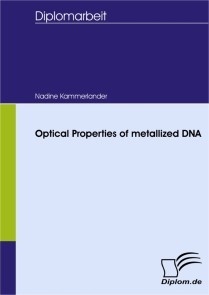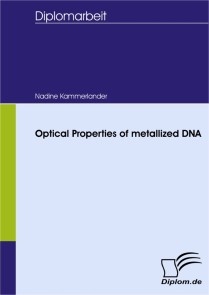Optical Properties of metallized DNA
68,00 €
inkl. 7% MwSt. und
ggf. zzgl. Versand
Inhaltsangabe:Introduction: Modern technologies cannot be imagined without electronic devices, as e.g. the success stories of transistors and diodes illustrate. The performance of these electronic devices has tremendously increased during the last decades through a process known as downscaling: Minimizing structural units allows for extremely high densities of electronic modules. This entails an increase of speed as well as an enhanced performance. Today"s photonic devices, however, are still rather large. The reason therefore can be found in the nature of light: Diffraction sets a lower limit for the scales of photonic devices and therefore prevents densely packed photonic components. The diffraction limit can be, however, overcome by so called "Surface Plasmon Polaritons" (SPPs): These are oscillations of the conducting electrons in a metallic nanoparticle induced by an incoming electromagnetic field with a suitable frequency. By this conversion of the optical mode to surface plasmons, the electromagnetic energy can be localized to regions of merely several tens of nanometers. This property is highly desirable for the construction of future optoelectronic devices: Chains of metallic nanoparticles, for example, are promising waveguides with lateral confinements below the diffraction limit. DNA is a potential pattern material for constructing nanostructures as it can be synthesized in almost arbitrary lengths in the nanometer scale and also allows for modifications that make site-specific reactions possible. Its inherent scaling limit is determined by the distance of two neighbored basepairs: This length is only 0.34nm and therefore much below the diffraction limit. Moreover, it seems very appealing to exploit the self-recognition properties of DNA to build functional nanostructures by self-assembly processes. Among all possible template-directed material syntheses, metallization of DNA is particularly interesting for photonic devices as it makes a controlled growth of metal nanoparticles with defined size and shape along the DNA template possible. Furthermore the use of DNA as a pattern promises to achieve a defined arrangement of the particles relative to each other. Experiments concerning metallization of DNA have been done for approximately a decade now. Most experiments, however, have concentrated on investigating the electrical conductance of the DNA. Absorption spectra have merely been recorded for verifying the existence of metallized DNA in the solution. The optical properties of metallic nanoparticles grown on DNA templates have remained almost completely unexplored up to now. Thus it is the main topic of this thesis to investigate the optical properties of metallized DNA structures, i.e. their absorption as well as scattering characteristics. Therefore two different metallization methods are applied and the resulting metallized particles are compared. Varying synthesis parameters, such as concentrations of the reagent or the reaction time systematically and analyzing the optical data, provides an understanding on what variables the metallization depends on. Changes in optical properties are related to changes in the size or structure of the nanoparticles. This information is extracted from polarized Dynamic Light Scattering experiments as well as Atomic Force Microscopy. Moreover Dynamic Light Scattering allows for direct monitoring of the nanoparticle growth; thereby the particle sizes as well as intensities are observed. These results are necessary to understand the DNA metallization process in detail and to be able to optimize the synthesis conditions on the way to a defined growth of metallic nanoparticles. Using various seed densities for site-specific DNA metallization and analyzing the resulting optical properties is a fist step to a defined arrangement of nanoparticles. This thesis is structured as follows: After a brief introduction into theory about the properties of metallic nanoparticles and about DNA in chapter 2, chapter 3 explains the two different methods of metallization that are used for synthesis. Chapter 4 addresses absorption spectrometry: After a short description of the working principle, absorption spectra of metallized DNA samples are shown for numerous varied parameters and analyzed. The results are finally discussed and compared with two different theories about nanoparticle absorption. Chapter 5 is about Dynamic Light Scattering: In a theoretical part, simulations are done for a later comparison with experimental data. The second half of the chapter presents first results for the various metallized DNA samples. In chapter 6 the necessity for stabilizers and their working principle is explained before some experimental data is shown. Chapter 6 handles with metallization of ring-like DNA structures. In chapter 8 micrographs recorded with an Atomic Force Microscope are presented and analyzed.Afterward the obtained results of this thesis are concluded and an outlook for future investigations is given. Inhaltsverzeichnis:Table of Contents: 1.Motivation1 2.Fundamentals3 2.1Metallic Nanoparticles3 2.2Optical Properties of Nanospheres4 2.2.1Extinction of Light4 2.3Optical Properties of Nanorods8 2.3.1Electrostatic Calculations9 2.4Deoxyribonucleic Acid11 2.4.1Composition and Properties11 2.4.2Metallized DNA12 3.Synthesis of Metallized DNA13 3.1Hybridization of DNA13 3.2Requirements for Metallization15 3.3Photochemical Metallization16 3.4Tollens Metallization of Aldehyde-Modified DNA16 3.5Materials Section18 4.Absorption Spectrometry19 4.1Principle of Absorption Spectrometry 19 4.2Absorption Measurements of UV-Metallized Samples20 4.2.1Influence of pH21 4.2.2DNA Sequence22 4.2.3Silver Amount25 4.2.4Irradiation Time27 4.2.5DNA Length29 4.2.6Reference Samples30 4.2.7Discussion31 4.3Absorption Measurements of Tollens-Metallized Samples37 4.3.1Absorption Measurements of Tollens-Metallized dsDNA38 4.3.2Absorption Measurements of Tollens-Metallized ssDNA42 4.3.3Development Solution43 4.3.4Data Analysis and Discussion45 5.Dynamic Light Scattering49 5.1Principle of Dynamic Light Scattering49 5.1.1Measurement Technique49 5.1.2Fundamentals49 5.1.3Polarized Dynamic Light Scattering52 5.1.4Apparatus53 5.2Unpolarized Measurements53 5.2.1Experimental Results53 5.2.2CONTIN Analysis55 5.2.3Temporal Evolution60 5.2.4Reference Samples61 5.3Polarized Measurements63 5.3.1Simulations63 5.3.2Experimental Results65 6.Stabilization of the Nanoparticles69 6.1Fundamentals69 6.2Experimental Results70 7.Nanorings74 8.Atomic Force Microscopy79 8.1Fundamentals79 8.2Sample Preparation79 8.2.1Requirements80 8.2.2Functionalization of Silicon Wafers82 8.3Results83 8.3.1Ultrasonication83 8.3.2MPTMS-Silanization 84 8.3.3Spin-Coating88 9.Conclusion89 10.Outlook91 ADNA Sequences93 BReference Samples94 B.1Absorption Spectroscopy94 B.2DLS96 B.3AFM97 CParameters of MPTMS-Silanization98 DAcknowledgments100 Textprobe:Text Sample: Chapter 4.2.7, Discussion: Comparison with Theory: The experimental values shall now be compared to theoretical calculations done by Slistan-Grijalva et al They applied Mie theory up to the tenth multipole for silver nanospheres in water. Although the metallized DNA structures are not assumed to be spherical particles, the experimental and theoretical values shall be compared to get a first insight about the processes happening during metallization. The theoretical values, that are shown in fig. 4.11 and 4.12, agree with experiments I did with commercial silver spheres in a range from 20 to 80nm in diameter, shown in fig. 4.13. For small particles, the peak position remains approximately constant. Small red shifts with increasing size are due to a radius-dependent dielectric function. Very small particles show broad peaks: In bulk medium the mean free path of electrons is 52nm. Thus for particles with a radius shorter than 26nm an additional damping mechanism, surface scattering, becomes important and increases the peak width. According to the electrostatic calculation in 2.2.1, the peak intensity is proportional to the volume. This is at least quantitatively in accordance with Slistan-Grijalva"s results for small particles. Theory predicts a significant red shift in the plasmon spectrum for larger particles since retardation effects, such as screening of the incoming wave, shift the plasmon peak to the red. The excitation of higher order modes, such as the quadrupole mode, broadens the spectrum. One aspect Slistan-Grijalva does not discuss, is polydispersity of the particle sizes. Thus experimental spectra will certainly show broader spectra than Slistan-Grijalva predicts. Another difference between my measurement conditions and Slistan-Grijalvas calculations is the refractive index of the surrounding medium. Slistan-Grijalva chose water and therefore a refractive index of 1.33. In the UV-metallization experiments, the aqueous solution contains various amounts of salt; the refractive index is therefore slightly increased. Moreover the influence of the DNA, namely its refractive index and the core-shell character of the resulting nanoparticles must not be ignored. The refractive index influences the absolute values of the peak position, the maximum absorbance as well as the bandwidth. The result of the UV metallization is, that the metallization process worked for all DNA samples. All spectra showed plasmon peaks in the same range and with similar shapes and widths. There were slight, reproducible differences, indeed, that shall be concluded and discussed in the following: All measurements show p

- Autor: Nadine Kammerlander
- Seitenzahl: 112
- Format: PDF
- DRM: social-drm (ohne Kopierschutz)
- Erscheinungsdatum: 10.11.2008
- Herausgeber: DIPLOM.DE
